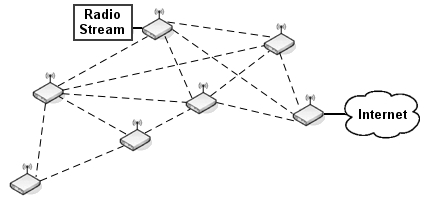We can help you to build the wireless solution you need. The range is from single router with Openwrt or proprietary software to mesh systems to cover large areas with a good wifi signal.
OpenWrt is an open source project for embedded operating system based on Linux, primarily used on embedded devices to route network traffic. All components have been optimized to be small enough to fit into the limited storage and memory available in home routers.
OpenWrt is configured using a command-line interface (ash shell), or a web interface (LuCI). There are about 3500 optional software packages available for installation via the opkg package management system.
Features:
• Extensible configuration of the entire hardware drivers, e.g. built-in network switches and their VLAN-capabilities, WNICs, DSL modems, FX, available hardware buttons, etc.
• Exhaustive possibilities to configure network-related features, like:
• IPv4 support.
• IPv6 native stack:
◦ Prefix Handling,
◦ Native IPv6 configuration (SLAAC, stateless DHCPv6, stateful DHCPv6, DHCPv6-PD),
◦ IPv6 transitioning technologies (6rd, 6to4, 6in4, ds-lite, lw4o6, map-e),
◦ Downstream IPv6 configuration (Router Advertisement, DHCPv6 (stateless and stateful) and DHCPv6-PD).
• Routing through iproute2, Quagga, BIRD, Babel etc.
• Mesh networking through B.A.T.M.A.N., OLSR and IEEE 802.11s-capabilities of the WNIC drivers and other ad hoc mesh routing protocols that have been implemented within Linux.
• Wireless functionality, e.g. make the device act as a wireless repeater, a wireless access point, a wireless bridge, a captive portal, or a combination of these with e.g. ChilliSpot, WiFiDog Captive Portal, etc.
• Wireless security: Packet injection, e.g. Airpwn, lorcon, e.a.
• Stateful firewall, NAT and port forwarding through netfilter; additionally PeerGuardian is available
• Dynamically-configured port forwarding protocols UPnP and NAT-PMP through upnpd, etc.
• Port knocking via knockd and knock
• TR-069 (CWMP) client[48]
• IPS via Snort (software)
• Active queue management (AQM) through the network scheduler of the Linux kernel, with many available queuing disciplines. CoDel has been backported to Kernel 3.3.[49] This encapsulates Traffic shaping to ensure fair distribution of bandwidth among multiple users and Quality of Service (QoS) for simultaneous use of applications such as VoIP, online gaming, and streaming media without experiencing the negative impacts of link saturation.
• Load balancing for use with multiple ISPs using source-specific routing
• IP tunneling (GRE, OpenVPN, pseudowire, etc.)
• Extensible realtime network monitoring and statistics through e.g. RRDtool, Collectd, Nagios, Munin lite, Zabbix, etc.
• Domain Name System (DNS) and DHCP through Dnsmasq, MaraDNS, etc.
• Dynamic DNS services to maintain a fixed domain name with an ISP that does not provide a static IP address
• Wireless distribution system (WDS) including WPA-PSK, WPA2-PSK, WPA-PSK/WPA2-PSK Mixed-Mode encryption modes
Mesh systems can create a single, facitlity-wide network name so there’s no need to constantly switch between networks as you roam around your home. Mesh systems keeps an eye on the signal strength to your device, and switches it seamlessly to another source if necessary. If you prefer separate network names for each frequency band, you can do that as well.
